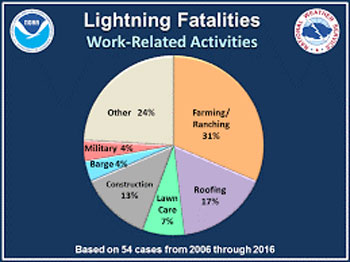As summer thunderstorms develop, it is important to remember one of the major hazards of these storms: lightning. In the United States, 300 people are struck by lightning on average each year. Each spark of lightning can reach over five miles in length, soar to temperatures of approximately 50,000°F, and contain 100 million electrical volts. Thunder is a result of the rapid expansion of heated air. Since light travels faster than sound in the atmosphere, the sound will be heard after the lightning. If you see lightning and hear thunder at the same time, that lightning is in your neighborhood!
The NWS tagline for thunderstorms is “When thunder roars, go indoors”. The ‘indoors’ means a substantial structure with walls, electricity, and plumbing. The electrical and plumbing systems provide a channel to move the electricity of the lightning bolt safely to ground. Open picnic shelters, gazebos, and porches don’t provide adequate shelter. When you are indoors, stay away from land-line phones, appliances, and plumbing. All of these can provide a conduit for the electrical charge.
Farmers, ranchers and others who work outdoors are among the most at risk (Figure 1). These occupations often place individuals at some distance from the nearest substantial structure. A fully enclosed metal vehicle, like a truck or a tractor, can provide some protection. The lightning energy is routed through the metal frame to the ground and away from you. Be as careful as possible not to touch anything that might carry the charge.

Metal buildings provide another dilemma – it might appear to be safe but actually might not provide much protection. If there are large openings, it is unlikely to provide sufficient structure to be a safe haven. Also, be cautious of concrete floors which likely have metal rebar as reinforcement that can also carry a charge and put you at risk. These metal reinforcements can also be a problem with concrete walls. It's really tempting to do indoor work during a thunderstorm. Remember, you do not want to use power tools, desktop computers, or anything plugged into the wall.
Additional precautions:
- Avoid open fields, the top of a hill, or a ridge top.
- Stay away from metal fencing. Electricity can travel miles along barbed wire (Figure 2).
- Stay away from tall, isolated trees or other tall objects. If you are in a forest, stay near a lower stand of trees.
- If you are in a group, spread out to avoid the current traveling between group members.
- Stay away from water and wet items such as ropes and hoses.
Water and metal do not attract lightning but they are excellent conductors of electricity. The current from a lightning flash will easily travel for long distances.

Figure 2. Cattle killed by lightning. Photo: Ruth Lyon-Bateman.
For more information on lightning safety, check out these resources:
https://www.weather.gov/media/owlie/Lightning-Brochure18.pdf
https://www.weather.gov/media/owlie/OSHA_FS-3863_Lightning_Safety_05-2016.pdf
https://scijinks.gov/lightning-detection/
Mary Knapp, Assistant State Climatologist
mknapp@ksu.edu
Christopher “Chip” Redmond, Kansas Mesonet Manager
christopherredmond@ksu.edu
Dan Regier, Web Developer
regierdp@ksu.edu